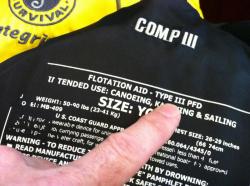Life Jacket Type Code Labels Go Away
from The Fishing Wire
Step Toward Eliminating Confusion and Introduction of New Designs
In an effort to be more consumer friendly and spur innovation, the US Coast Guard is dropping its Type I-V labeling system.ANNAPOLIS, MD. — In a move that’s expected to benefit recreational boaters, on Oct. 22 the US Coast Guard will drop the current life jacket type code scheme — Type I, II, III, IV and V — that has been used for years to label and differentiate the types of life jackets and their specific use. Chris Edmonston, BoatUS Foundation for Boating Safety President and Chairman of the National Safe Boating Council, said, “The boating safety community believes this move by the Coast Guard will help lead the way toward more comfortable and innovative life jacket designs, help boaters stay on the right side of the law, lower costs, and save lives.”
Explains Edmonston, “This is positive news is that we will no longer see a Type I, II, III, IV or V label on a new life jacket label after Oct. 22. This type coding was unique to the United States, tended to confuse boaters, limited choice and increased the cost of life jackets.” He says removing the type coding is a first step towards the adoption of new standards that will eventually simplify life jacket requirements for recreational boaters.
“This move is expected to lead to the introduction of new life jacket designs, especially those made in other countries as US standards will be more ‘harmonized,’ initially Canada and eventually the European Union,” said Edmonston. “Along with a wider variety, aligning our standards with those to our neighbor to the north and across the Atlantic will help reduce prices as manufacturers won’t have to make products unique to the US market.”
Inflatable PFD’s have become very popular in recent years thanks to their comfort and ease of stowage.However, Edmonston cautions boaters must still abide by the current standards when using older life jackets marked with the Type I-V labeling, as they will remain legal for use. “We must continue to have a properly fitted life jacket for all aboard, and as always, you’ll need to follow the label’s instructions regardless of when it was made. Simply put, if you follow the label, you’re following the law.” A full list of the current life jacket types and descriptions can be found at BoatUS.org/life-jackets, and any update on new life jacket types and styles will be posted here when available.
In additional effort to help change the mindset of what a life jacket must look like, The BoatUS Foundation, the Personal Floatation Device Manufacturers Association (PFDMA) and the National Marine Manufacturers Association (NMMA), recently kicked off a “Innovations in Life Jacket Design Competition” to seek out the newest technologies and design ideas. Running through April 15, 2015, the contest seeks entries from groups or individuals, including collegiate design programs, armchair inventors or even boat and fishing clubs. Entries may be as simple as hand-drawn theoretical designs to working prototypes and will be judged based on four criteria: wearability, reliability, cost and innovation. For more, go to BoatUS.org/design.
###
About the BoatUS Foundation:
The BoatUS Foundation for Boating Safety and Clean Water is a national leader promoting safe, clean and responsible boating. Funded primarily by donations from over half-million members of BoatUS, it provides innovative educational outreach directly to boaters and anglers with the aim of reducing accidents and fatalities, increasing stewardship of America’s waterways and keeping boating safe for all. A range of boating safety courses – including 33 free state courses – can be found at BoatUS.org/courses.

